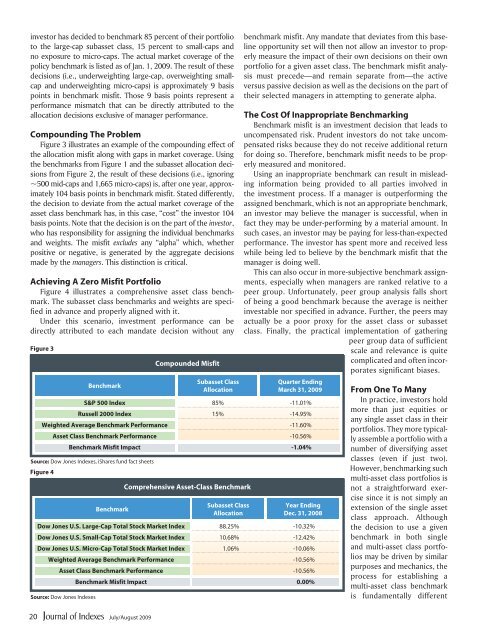How to Kill a Black Swan Remy Briand and David Owyong ...
How to Kill a Black Swan Remy Briand and David Owyong ...
How to Kill a Black Swan Remy Briand and David Owyong ...
Create successful ePaper yourself
Turn your PDF publications into a flip-book with our unique Google optimized e-Paper software.
inves<strong>to</strong>r has decided <strong>to</strong> benchmark 85 percent of their portfolio<br />
<strong>to</strong> the large-cap subasset class, 15 percent <strong>to</strong> small-caps <strong>and</strong><br />
no exposure <strong>to</strong> micro-caps. The actual market coverage of the<br />
policy benchmark is listed as of Jan. 1, 2009. The result of these<br />
decisions (i.e., underweighting large-cap, overweighting smallcap<br />
<strong>and</strong> underweighting micro-caps) is approximately 9 basis<br />
points in benchmark misfit. Those 9 basis points represent a<br />
performance mismatch that can be directly attributed <strong>to</strong> the<br />
allocation decisions exclusive of manager performance.<br />
Compounding The Problem<br />
Figure 3 illustrates an example of the compounding effect of<br />
the allocation misfit along with gaps in market coverage. Using<br />
the benchmarks from Figure 1 <strong>and</strong> the subasset allocation decisions<br />
from Figure 2, the result of these decisions (i.e., ignoring<br />
~500 mid-caps <strong>and</strong> 1,665 micro-caps) is, after one year, approximately<br />
104 basis points in benchmark misfit. Stated differently,<br />
the decision <strong>to</strong> deviate from the actual market coverage of the<br />
asset class benchmark has, in this case, “cost” the inves<strong>to</strong>r 104<br />
basis points. Note that the decision is on the part of the inves<strong>to</strong>r,<br />
who has responsibility for assigning the individual benchmarks<br />
<strong>and</strong> weights. The misfit excludes any “alpha” which, whether<br />
positive or negative, is generated by the aggregate decisions<br />
made by the managers. This distinction is critical.<br />
Achieving A Zero Misfit Portfolio<br />
Figure 4 illustrates a comprehensive asset class benchmark.<br />
The subasset class benchmarks <strong>and</strong> weights are specified<br />
in advance <strong>and</strong> properly aligned with it.<br />
Under this scenario, investment performance can be<br />
directly attributed <strong>to</strong> each m<strong>and</strong>ate decision without any<br />
Figure 3<br />
Source: Dow Jones Indexes, iShares fund fact sheets<br />
Figure 4<br />
Source: Dow Jones Indexes<br />
Benchmark<br />
Benchmark<br />
Compounded Misfit<br />
Subasset Class<br />
Allocation<br />
Comprehensive Asset-Class Benchmark<br />
Subasset Class<br />
Allocation<br />
benchmark misfit. Any m<strong>and</strong>ate that deviates from this baseline<br />
opportunity set will then not allow an inves<strong>to</strong>r <strong>to</strong> properly<br />
measure the impact of their own decisions on their own<br />
portfolio for a given asset class. The benchmark misfit analysis<br />
must precede—<strong>and</strong> remain separate from—the active<br />
versus passive decision as well as the decisions on the part of<br />
their selected managers in attempting <strong>to</strong> generate alpha.<br />
The Cost Of Inappropriate Benchmarking<br />
Benchmark misfit is an investment decision that leads <strong>to</strong><br />
uncompensated risk. Prudent inves<strong>to</strong>rs do not take uncompensated<br />
risks because they do not receive additional return<br />
for doing so. Therefore, benchmark misfit needs <strong>to</strong> be properly<br />
measured <strong>and</strong> moni<strong>to</strong>red.<br />
Using an inappropriate benchmark can result in misleading<br />
information being provided <strong>to</strong> all parties involved in<br />
the investment process. If a manager is outperforming the<br />
assigned benchmark, which is not an appropriate benchmark,<br />
an inves<strong>to</strong>r may believe the manager is successful, when in<br />
fact they may be under-performing by a material amount. In<br />
such cases, an inves<strong>to</strong>r may be paying for less-than-expected<br />
performance. The inves<strong>to</strong>r has spent more <strong>and</strong> received less<br />
while being led <strong>to</strong> believe by the benchmark misfit that the<br />
manager is doing well.<br />
This can also occur in more-subjective benchmark assignments,<br />
especially when managers are ranked relative <strong>to</strong> a<br />
peer group. Unfortunately, peer group analysis falls short<br />
of being a good benchmark because the average is neither<br />
investable nor specified in advance. Further, the peers may<br />
actually be a poor proxy for the asset class or subasset<br />
class. Finally, the practical implementation of gathering<br />
peer group data of sufficient<br />
scale <strong>and</strong> relevance is quite<br />
complicated <strong>and</strong> often incorporates<br />
significant biases.<br />
Quarter Ending<br />
March 31, 2009<br />
S&P 500 Index 85% -11.01%<br />
Russell 2000 Index 15% -14.95%<br />
Weighted Average Benchmark Performance -11.60%<br />
Asset Class Benchmark Performance -10.56%<br />
Benchmark Misfit Impact -1.04%<br />
Year Ending<br />
Dec. 31, 2008<br />
Dow Jones U.S. Large-Cap Total S<strong>to</strong>ck Market Index 88.25% -10.32%<br />
Dow Jones U.S. Small-Cap Total S<strong>to</strong>ck Market Index 10.68% -12.42%<br />
Dow Jones U.S. Micro-Cap Total S<strong>to</strong>ck Market Index 1.06% -10.06%<br />
Weighted Average Benchmark Performance -10.56%<br />
Asset Class Benchmark Performance -10.56%<br />
Benchmark Misfit Impact 0.00%<br />
From One To Many<br />
In practice, inves<strong>to</strong>rs hold<br />
more than just equities or<br />
any single asset class in their<br />
portfolios. They more typically<br />
assemble a portfolio with a<br />
number of diversifying asset<br />
classes (even if just two).<br />
<strong>How</strong>ever, benchmarking such<br />
multi-asset class portfolios is<br />
not a straightforward exercise<br />
since it is not simply an<br />
extension of the single asset<br />
class approach. Although<br />
the decision <strong>to</strong> use a given<br />
benchmark in both single<br />
<strong>and</strong> multi-asset class portfolios<br />
may be driven by similar<br />
purposes <strong>and</strong> mechanics, the<br />
process for establishing a<br />
multi-asset class benchmark<br />
is fundamentally different<br />
20<br />
July/August 2009
















